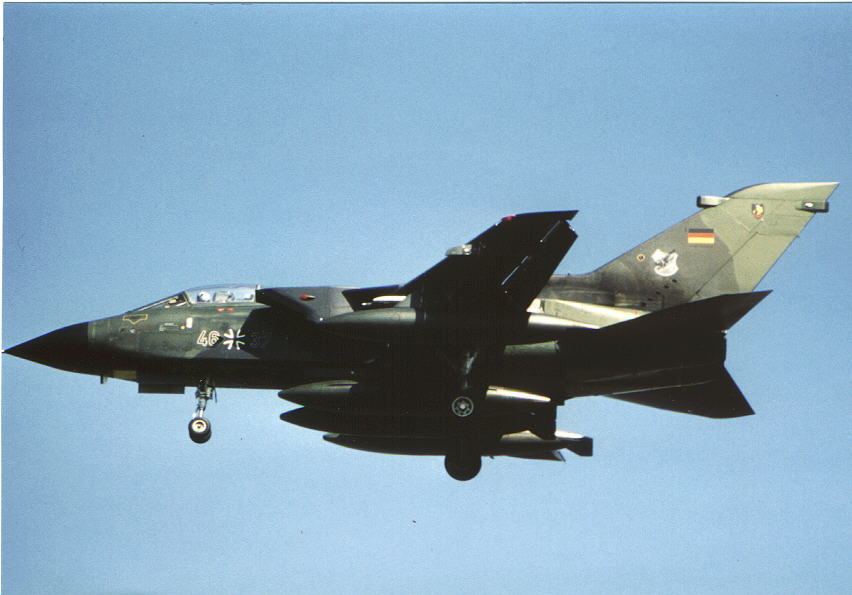|
|
|
![]()
TORNADO

PANAVIA TORNADO GR1/1A IDS (INTERDICTOR/STRIKE)
The Tornado design and development programme began during 1968 when a multinational feasibility study was initiated, eventually resulting in the Multi-Role Combat Aircraft (MRCA) which flew for the first time on 14 August 1974. Following extensive developmental flying, the first production-standard aircraft were completed towards the end of the 1970s and the first Tornado GR1 for the Royal Air Force was delivered on 1 July 1980 to RAF Cottesmore, home of the TTTE (Trinational Tornado Training Establishment).
The Tornado GR1 is numerically and tactically the Royal Air Force's most important aircraft, a low-level strike and attack weapons platform designed to replace the Vulcan in the strike role, and both the Canberra and much of the Jaguar fleet in the tactical offensive support role. The aircraft are assigned to NATO and four squadrons are currently deployed to Germany, based at RAF Bruggen, with a reserve unit based in th UK (assigned to weapons conversion training). Tornado GR1s are equipped with a variety of weaponry, ranging from 1,000 lb free-fall or laser-guided bombs, BL.755 cluster bomb. Internal armament comprises two Mauser 27mm cannon, and self-defence capability is provided by AIM-9L Sidewinder AAMs, one of which can be carried under each wing. Other defensive equipment includes Sky Shadow ECM pods and the BOZ-107 chaff/flare dispenser.
The Tornado GR1A is a day/night all-weather tactical reconnaissance aircraft, developed from the 'Alpha' model. Flying for the first time during July 1985, the GR1A entered RAF service in May 1987 and now equips Nos. 2 and 13 Squadrons based at RAF Marham. The GR1A carries no optical camera equipment and relies exclusively on synthetic electro-optical sensor which provide better all-weather performance an facilitate easier interpretation. Recorded video film can be replayed in flight, or transmitted to a ground unit in 'real time' if necessary, and the aircraft retains its combat copability although the twin Mauser cannon fit has been removed in order to accommodate the reconnaissance sensors. The Tornado GR1A was used operationally for the first time during the Gulf War in 1991.
The Tornado GR1B has replaced the Buccaneer in the maritime strike role, some twenty-four aircraft having been modified to carry four (eventually five) Sea Eagle anti-ship missiles, retaining the GR1A's combat capability and acquiring the Buccaneer's 'buddy-buddy' in-flight refuelling capacity. The Tornado GR4 is the latest (and probably th ultimate) derivative of the basic IDS (interdictor/Strike) airframe, and applies to RAF Tornado GR1 which will undergo a mid-life update towards the end of the decade.
PANAVIA TORNADO F3 ADV (AIR DEFENCE VERSION)
Developed as a part of the multinational MRCA programme, the Tornado ADV (Air Defence Variant) was designed in response to the Royal Air Force's requirement for a long-range stand-off interceptor. Although both th Lightning and Phantom were wellestablished in RAF service during the 1970s, both aircraft were approaching obsolescence and neither possessed a true long-range interception capability. The Tornado ADV was designed specifically to undertake combat air patrols at huge distances from the mainland United Kingdom, and to be able to maintain such patrols for extended periods. Armed with the British Aerospace Sky flash AAM, the aircraft would be capable of intercpting incoming hostile bombers at BVR (Beyond Visual Range) distances.
So much for the theory; unfortunately the concept of a BVR interceptor was flawed and did not take into account the very real possibilities of close-in 'dogfighting' scenarios. The Tornado ADV programme proceeded however, but by the time the aircraft entered Royal Air Force service it was becoming clear that the RAF had acquired the right aircraft for the wrong job. Worse still, the Tornado ADV's develepment programme was plagued with problems and delays which earned the aircraft an unenviable (and largely unfair) reputation as a proverbial 'white elephant'. The first Tornado F2s were delivered to RAF Coningsby in 1984, equipped with Turbo Union RB199-34R Mk 103 engines each delivering 16,920 lb thrust and a weapon fit of four Sky Flash and four AIM-9L Sidewinders, together with an internal 27mm cannon.
With a top speed in excess of Mach 2, the Tornado F2 might not have been highly manoeuvrable dofighter, but it was certainly a sprightly interceptor. Sadly, th performance of the AI-24 Fowhunter radar did not match the airframe's impressive performance, and continual delays in radar development led to many Tornado F2s being delivered to the RAF without any radar, a block of concrete ballast ocupying the fighter's nose cone (leading to sarcastic press references to the F2s was quickly replaced by larde-scale deliveris of Tornado F3s, with uprated Mk 104 engines, automatic wing sweep, and a fully functioning Foxhunter radar, although problems weth the latter equipment continued for some time and it wasn't until the early 1990s that the RAF finally acquired what was effectively a fully capable Tornado F3 force. Now established in RAF service F3 will remain in use until the Eurofighter (in whatever form) finally becomes noperational with the RAF, at which stage the Tronado F3 is an outstanding interceptor (especially in the hands of an experienced RAF pilot), but the RAF is unlikely to mourn its eventual demise